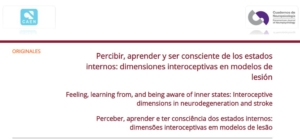Percibir, aprender y ser consciente de los estados internos: dimensiones interoceptivas en modelos de lesión
Cuadernos de Neuropsicología
García-Cordero, I., Sedeño, L., de la Fuente, L., Slachevsky, A., Forno, G., Klein, F., Lillo, P., Ferrari, J., Rodriguez, C., Bustin, J., Torralva, T., Morales, A., Muñoz, E., Baez, S., Yoris, A., Esteves, S., Melloni, M., Salamone, P., Huepe, D., Manes, F., García, A. M. & Ibáñez, A. (2018). Percibir, aprender y ser consciente de los estados internos: dimensiones interoceptivas en modelos de lesión. Cuadernos de Neuropsicología 12(3), 1-22. Online: https://bit.ly/2JNLF6t.
Este trabajo indaga en la organización cerebral de tres dimensiones de la interocepción, a saber, la capacidad de sentir y monitorear nuestros estados corporales internos. Para ello, empleamos una tarea de interocepción cardiaca y examinamos los correlatos neurales de las tres dimensiones a través de neuroimágenes estructurales y funcionales en estado de reposo y mediciones online del potencial evocado cardíaco. Nuestros hallazgos, derivados de pacientes con enfermedad de Alzheimer, la variante conductual de la demencia frontotemporal y lesiones fronto-insulares por accidente cerebrovascular, muestran cómo el daño en nodos específicos de una amplia red fronto-temporo-insular compromete de manera diferenciada las dimensiones interoceptivas y cómo las alteraciones estructurales afectan las conexiones funcionales más allá de esos centros críticos.
Para acceder al artículo completo hacé click AQUÍ
Percibir, aprender y ser consciente de los estados internos: dimensiones interoceptivas en modelos de lesión
Cuadernos de Neuropsicología
García-Cordero, I., Sedeño, L., de la Fuente, L., Slachevsky, A., Forno, G., Klein, F., Lillo, P., Ferrari, J., Rodriguez, C., Bustin, J., Torralva, T., Morales, A., Muñoz, E., Baez, S., Yoris, A., Esteves, S., Melloni, M., Salamone, P., Huepe, D., Manes, F., García, A. M. & Ibáñez, A. (2018). Percibir, aprender y ser consciente de los estados internos: dimensiones interoceptivas en modelos de lesión. Cuadernos de Neuropsicología 12(3), 1-22. Online: https://bit.ly/2JNLF6t.
Interoception is a complex process encompassing multiple dimensions, such as accuracy, learning and awareness. Here we examined whether each of those dimensions relies on specialized neural hubs distributed throughout the vast interoceptive network. To this end, we obtained relevant measures of cardiac interoception in healthy subjects and patients offering contrastive lesion models of neurodegeneration and focal brain damage: behavioral variant frontotemporal dementia (bvFTD), Alzheimer’s disease (AD), and fronto-insular stroke. Neural correlates of the three dimensions were examined through structural and functional restingstate imaging and online measurements of the heart-evoked potential (HEP). The three patient groups presented deficits in interoceptive accuracy, associated to insular damage, connectivity alterations, and abnormal HEP modulations. Interoceptive learning was differentially impaired in AD patients, suggesting a key role of memory networks in this skill. Interoceptive awareness results showed that bvFTD and AD patients overestimated their performance; this pattern was associated with abnormalities in anterior regions and associated networks subserving metacognitive processes, and probably related to well-established insight deficits in dementia. Our findings indicate how damage to specific hubs in a broad fronto-temporo-insular network differentially compromises interoceptive dimensions, and how such disturbances affect widespread connections beyond those critical hubs. This is the first study in which a multiple lesion model reveals fine-grained alterations of body sensing, offering new theoretical insights into neuroanatomical foundations of interoceptive dimensions.
To access the full paper please click HERE



